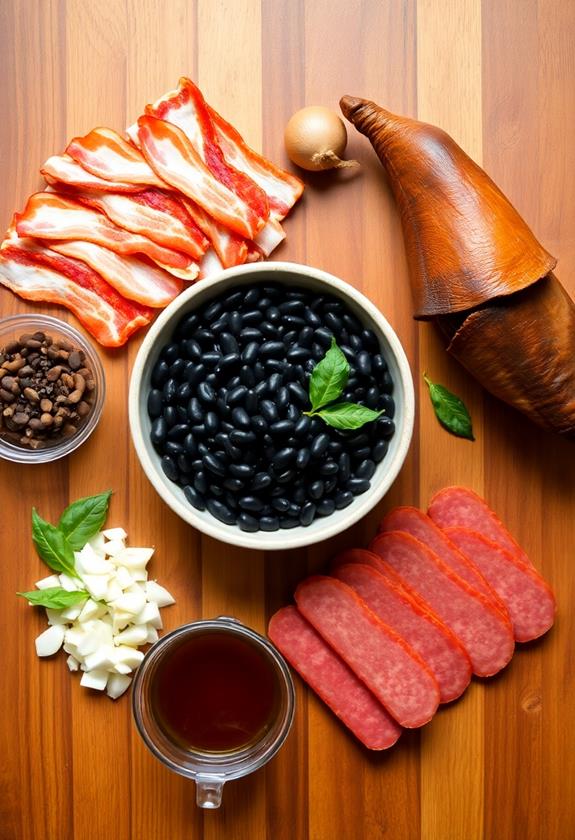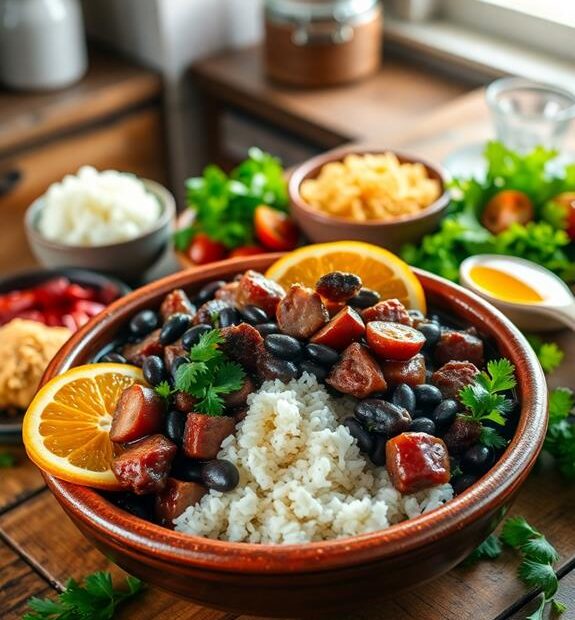Feijoada is a tasty Brazilian dish, right? It's a hearty stew made with black beans and various cuts of pork, like bacon and sausage. Traditionally, it comes from the 16th century, created by enslaved Africans using leftover meats. You soak the beans overnight and simmer everything together, creating rich flavors. Feijoada's often enjoyed during family gatherings, served with rice, oranges, and farofa. Can you imagine how comforting it must feel to share this meal with loved ones? �� If you want to whip up this delicious dish or learn about its cultural roots, there's plenty more to discover!
History

Feijoada, a beloved Brazilian black bean stew, has roots that trace back to the 16th century, when enslaved Africans in Brazil began utilizing leftover pork scraps and black beans to create a hearty meal.
The dish is often made in large smokers, similar to those used for cooking meats perfectly, which allows for a rich blend of flavors. This dish isn't just food; it's a symbol of cultural significance.
Can you imagine the rich flavors that come from blending African and Portuguese traditions? Feijoada carries historical importance, reflecting the lives of the 1.3 million enslaved Africans brought to Brazil.
Traditionally served on Wednesdays and Saturdays, it's a communal dish, enjoyed by everyone from all social classes. Whether at a family gathering or a festive celebration, feijoada brings people together, making it a true icon of Brazilian cuisine.
Isn't that special?
Recipe

Feijoada is a beloved traditional Brazilian dish that brings warmth and comfort with its rich and smoky flavors. Known for its hearty blend of black beans and various cuts of pork, this stew is perfect for family gatherings or special occasions. Cooking feijoada is a labor of love that begins with soaking dry black beans overnight, allowing them to soften and absorb flavors during the long simmering process.
The combination of meats, aromatics, and spices creates a delightful harmony that's sure to impress your guests. For a quicker cooking experience, consider using a modern pressure cooker that can greatly reduce the time required to prepare this dish, providing top-rated cooking appliances for your culinary needs.
To serve feijoada is to celebrate Brazilian culinary culture. Traditionally, it's accompanied by fluffy white or brown rice, which balances the richness of the stew, and slices of fresh oranges that add an invigorating contrast. A sprinkle of farofa, made from toasted cassava flour, provides a delightful crunch and enhances the overall experience. Gather your ingredients and let's plunge into this flavorful journey!
Ingredients:
- 1 pound dry black beans
- 4 ounces bacon, chopped
- 1 smoked ham hock
- 1 pound sausage (such as chorizo or linguiça), sliced
- 1 onion, diced
- 4 cloves garlic, minced
- 2 bay leaves
- 1 teaspoon black pepper
- 1 teaspoon paprika
- Salt to taste
- 6 cups water or chicken broth
- 2 oranges, sliced (for serving)
- Cooked white or brown rice (for serving)
- Farofa (toasted cassava flour, for serving)
In a large pot, begin by soaking the black beans overnight in plenty of water. The next day, drain and rinse the beans. In the same pot, cook the chopped bacon over medium heat until crispy.
Add the smoked ham hock, sliced sausage, diced onion, and minced garlic, sautéing until the onions are translucent and fragrant. Stir in the soaked black beans, bay leaves, black pepper, paprika, and salt. Pour in the water or chicken broth, bringing the mixture to a boil before reducing the heat to low.
Cover the pot and let it simmer for about 2 to 3 hours, or until the beans are tender and the flavors have melded together. Adjust seasoning as needed.
When making feijoada, it's important to keep an eye on the liquid level during the cooking process. If the stew becomes too thick, feel free to add a little more water or broth to achieve your desired consistency.
Additionally, for a more robust flavor, consider adding other meats such as beef or additional types of sausage. Leftovers can be stored in the refrigerator for a few days or frozen for later enjoyment, as the flavors continue to deepen over time. Enjoy your feijoada with family and friends, celebrating the vibrant flavors of Brazilian cuisine!
Final Thoughts

When you gather around the table to enjoy this hearty dish, you're not just savoring a meal; you're embracing a rich tradition that brings people together. Feijoada, the beloved Brazilian black bean stew, is more than just comfort food.
It combines delicious pork and beef with soaked beans and fragrant bay leaves, much like how composting combines various organic materials for a sustainable purpose (the benefits of composting).
Whether you use a slow cooker or simmer it on the stove, the magic happens when the flavors meld together over time.
You might ask, what makes a traditional feijoada special? It's the communal experience of sharing this dish with family and friends, often served with rice and orange slices.

